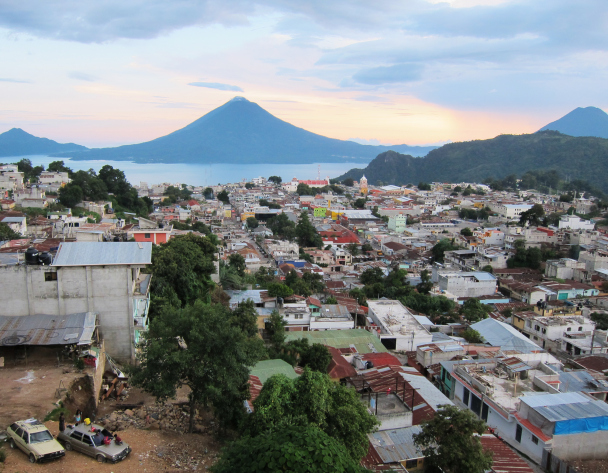- Australia and New Zealand
- East Asia and the Pacific
- Europe and Central Asia
- Albania
- Armenia
- Austria
- Azerbaijan
- Belarus
- Belgium
- Bosnia and Herzegovina
- Bulgaria
- Croatia
- Cyprus
- Czech Republic
- Denmark
- Estonia
- Finland
- France
- Georgia
- Germany
- Greece
- Hungary
- Iceland
- Ireland
- Italy
- Kazakhstan
- Kyrgyz Republic
- Latvia
- Liechtenstein
- Lithuania
- Luxembourg
- Malta
- Netherlands
- Norway
- Poland
- Portugal
- Romania
- Russian Federation
- Serbia
- Slovak Republic
- Slovenia
- Spain
- Sweden
- Switzerland
- Turkey
- Ukraine
- United Kingdom
- Uzbekistan
- Middle East and North Africa
- North America
- South Asia
- Sub-Saharan Africa
Home > Countries > Latin America and the CaribbeanGuatemala
Country Profile
 Source: Gareth Leonard, KIVA Fellows 2012 - Sololá, Guatemala
Source: Gareth Leonard, KIVA Fellows 2012 - Sololá, GuatemalaGuatemala has a population of 14.8 million 49% of which lives in urban areas. The total population growth and the urban population growth in the country were 3% in 2011 (WDI 2011).
In Guatemala the housing finance system remains relatively underdeveloped. The main reason for the lack of access to housing loans is that many people lack the resources to make down payment requirements because of the relatively low savings rate throughout Guatemala. Additionally, incomes are very volatile with remittances accounting for a large portion of GDP (12% in recent years) which makes it difficult to underwrite formal loans.
Less than half of all property is held without a formal title (IDB). Costs for formally registering property deter many from registering a transaction. A VAT on second-hand home sales also increases the cost of formal transfers of property promoting more informal exchanges.
The amount of home mortgage loans outstanding at the end of year as a percent of GDP has grown from 4.4% in 2007 from to 5.9% in 2011 (Superintendencia de Bancos). During this period the total amount of mortgage loans outstanding has nearly doubled from $1447 million USD to $2774 million USD.
The banking sector is the major provider of housing loans in Guatemala. The housing finance system’s funds are drawn primarily from deposits from the public and the banks’ capital reserves. General international credit lines to the banks and specific credit lines for housing loans from second tier banks play a smaller role (IDB). The Instituto de Fomento de Hipotecas Aseguradas (FHA)is an independent state-backed mortgage insurance agent that in 2009 approved policies representing 72% of the total flow of housing loans (IDB).The loans insured by the FHA are fully covered meaning that the banks who issue the loans have their capital completely protected in the case of a default on the housing loan. A few banks play the main role in financing the housing sector in the country. Citibank and G&T Continental hold 55% of total mortgages insured by the FHA, while BANRURAL, Banco Industrial and Banco Reformador hold another 35% of FHA-insured mortgages.
Microfinance for housing in Guatemala represents an opportunity to increase access to housing credit for lower income households. Housing is the second largest expenditure after food for the 56% of Guatemalans living in poverty (World Bank). Houses are generally of low quality with 20% lacking one or more basic services and 25% suffering from overcrowding (Guatemalan Vice-Ministry of Housing). For the 74% of Guatemalans who are unbanked microfinance institutions may play an important role in extending credit for housing (WRI). In the past decade microfinance institutions have expanded in Guatemala. Most loans from the microfinance sector are dedicated to improving existing homes rather than building new ones. Whereas the banking sector is concentrated in a few major cities, increasing microfinance allows for a larger number of Guatemalans living in small towns and rural areas to gain access to housing loans.
Copyright © 2025. HOFINET. By using or accessing this website, you signify that you agree to the Terms of Use.
When using or citing any information displayed on this website or accompanying blog sites, you must provide a reference to HOFINET.